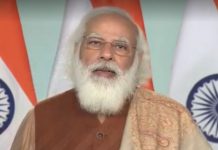From Pathan to Oppenheimer to CJI, where and when will this stop? Or will it? Will someone from the Government step in to say this far and no further?
If earlier the dispute was colour, read besharam rang, then this time around it is the scriptures.
Earlier if the row was around a Hindi movie, then this time an English language film is being targeted.
The common thread: either ban the film or delete the objectionable parts.
The context: Colour, words and verse in that order.
When Shahrukh Khan-Deepika Padukone starrer Pathan, which later turned out to be a blockbuster, was released, there was a storm over a song.
In one scene, Padukone was clad in a saffron-coloured bikini as she danced to the song Besharam rang.
Literally translated, Besharam Rang means shameless colour.
Hell broke loose with the BJP alleging that the saffron colour is being degraded.
It was of no relevance that the colour was one of the many bikinis Padukone adorned of which saffron, rather orange, happened to be one.
For the record, it may be pointed out that saffron is associated with the BJP. In fact its symbol is saffron based.
The protest had its effect and the Central Board of Film Certification or the CBFC made “adequate changes”. Consequently, the sanitized version had what were then termed as “suitable shots”. In other words, saffron was no longer besharam rang, at least as far as Pathan was concerned.
Cut to 2023: In the eye of a storm was Adipurush, a Prabhas-Kriti Sanon starrer with its adaptation of epic Ramayana.
Unlike Pathan where the lyrics conflicted with clothes, this time around it was about the dialogues: Lord Hanuman delivering lines like “Kapda tere baap ka, tel tere baap ka! Jalegi bhi teri baap ki” and “Jo humaari beheno ko haath lagaega, unki lanka laga denge”.
The dialogue writer Manoj Muntashir Shukla’s defence that this was done for “simplicity” did not cut ice.
Once again, hell broke loose and Shukla’s head was on the chopper block for hurting Hindu sentiment.
Add to this, actor Saif Ali Khan’s remarks that Ravan comes across as “humane” in the film. The backlash that followed left no option for Khan to publicly apologize and state on record his loyalty to Lord God Ram.
In Adipurush, Khan plays the character of Ravan.
The fact that Khan is a Muslim, made it worse for him because the self-styled flag bearers also targeted him and called him an ‘anti-Hindu Muslim’.
The protests, however, did not stop here.
Even Kriti Sanon, who plays Sita, was on the mat on grounds that she had in the past performed a ‘vulgar’ dance sequence and was thus considered “unfit” to play Sita.
In the case of Adipurush, the protests crossed borders.
In Nepal, Kathmandu’s Mayor Balen Shah objected to a dialogue in the film wherein Sita is described as the “daughter of India”.
Sita, Balen Shah wrote, is considered the daughter of Nepal. He also issued an ultimatum to the producers giving them three days to alter the line if they wanted to release the film in Nepal.
Geography apart, film makers, actors, dialogue writers and all else, have to tread with caution. In other words, irrespective of the number of steps forward they have to retreat if and when they cross the Lakshman Rekha or break a rule that cannot be broken.
When Brahmastra was released, there were protests to ban the film because its lead actor, Ranbir Kapoor had, in the past, said that he was a beef lover.
The lesson: do not essay roles that propagate ethics and an austere lifestyle if you cannot follow them in real life. Put simply, this means that if Ranbir Kapoor eats beef he must stop immediately if he wants to bag roles showcasing the Gods or the Hindu culture.
Having said that, what about Christopher Nolan and the biographical thriller Oppenheimer which he wrote and directed?
For the record, Oppenheimer chronicles the life of physicist Robert Oppenheimer who is credited with developing the first nuclear weapon and ushering in the Atomic Age.
So where did the filmmaker go wrong? Rather what did he do to raise the hackles of the Hindus and the Hindu-minded people in India?
However, this time around, the debate was not confined to the saffron brigade. It went beyond.
This time, the focus was the sanctity of the text. On this count, film makers, netizens, and NGOs joined the bandwagon.
Union Minister for Information and Broadcasting Anurag Singh Thakur upped the ante and rapped the Censor Board and demanded accountability for approving the objectionable content.
That apart, Information Commissioner Uday Mahurkar too questioned CBFC’s approval even as he failed to decipher the “motivation and logic behind this unnecessary scene on the life of a scientist”. The scene, he said, was “a direct assault on religious beliefs of a billion tolerant Hindus,” even as he compared it to “waging a war on the Hindu community.”
Or writer-director Ram Gopal Varma who doubted whether the nuclear scientist had read the Gita.
The furore is about an intimate scene where the protagonist Oppenheimer invokes a verse from the Bhagvad Gita while making love.
If reports are anything to go by, Oppenheimer was said to be influenced by the Bhagavad Gita.
In an interview, the physicist had recalled that the only thought which came to his mind after he witnessed the first detonation of a nuclear weapon on July 16, 1945, was a verse from the ancient Hindu text — “Now I am become Death, the destroyer of world.”
It is this line that finds its way in the controversial scene in the film.
On one count, the Hindus and believers are perhaps right in their objections.
For many, the Gita is a holy book. Therefore to find it being quoted while making love can make many squirm if not scream. So at one level, it may be less about religion and more about defiling sanctity.
However at another level, there are political elements who would do what it takes to disturb peace and create situations that could damage the social fabric of this country.
These are the same elements who are not only overactive on social media but also comprise the troll army.
To dismiss them as goons of the online world would be underplaying their role and reach. Many in India mistake them as being nationalists except their nationalism is more to do with their allegiance to their masters rather than the country.
Contrary to perception, the troll armies are not exclusive to the BJP but exist across parties. That the BJP’s machinery outweighs and outwits those run by others is another matter.
The common thread: spew venom and be abusive, especially to those who are high profile.
A case in point: trolling of Chief Justice of India D.Y. Chandrachud.
This has led to a dozen MPs writing to President Droupadi Murmu to act against a “troll army”, for its “filthy” and “deplorable” comments” adding that this was not possible without the support of the ruling dispensation”.
The attack followed as a five-judge constitution bench, headed by Justice Chandrachud, dealt with issues arising from the change of government in Maharashtra last year. The matter is sub-judice.
So what does this tell us? From Pathan to Oppenheimer to CJI, where and when will this stop? Or will it? Will someone from the Government step in to say this far and no further? Or will they continue to look the other way simply because the Party they belong to is a major player in the way things have unfolded? Many questions and few, rather no, answers.













